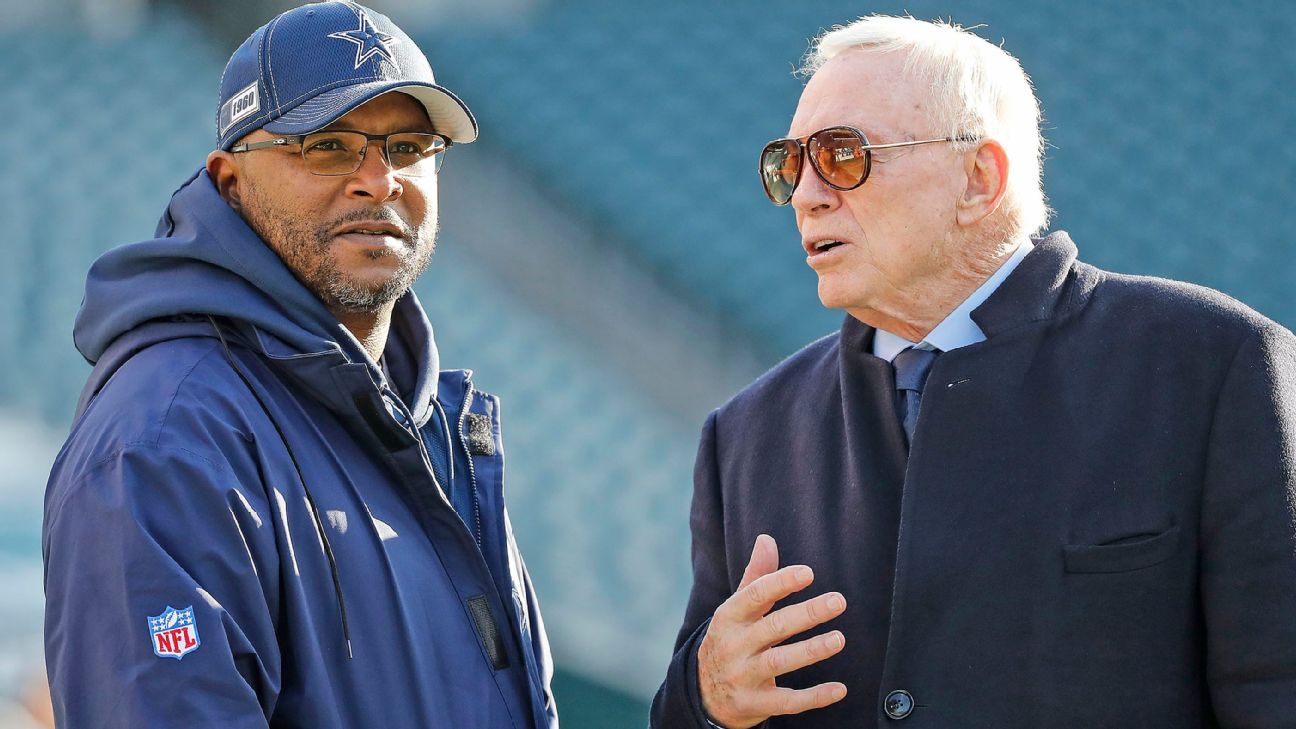FRISCO (Texas) — Jason Garrett kept Ted Williams’ picture on his desk as he was the head coach of Frisco. Dallas CowboysEvery spring, it reminded him what was most important in the NFL draft.
The picture was from Williams’ book, “The Science of Hitting,” with seven baseballs going across the strike zone and 11 down the zone. Each baseball contained the batting average, which was correlated with the pitch location. The highest batting average was belt-high above the middle of the plate. You can’t go too high or low, too far inside, too far out, or too close to the center, and you will see your numbers drop.
Williams’ first mantra was, “get a good pitch to hit.”
“To me, that’s such a great reminder and we’re talking the greatest hitter of all time,” Garrett said. “You can take a chance and swing at a pretty bad pitch way out there and roll the dice, but you’ll have success two out of 10 times. If you take one in the middle of the plate, you’ll have success five out of 10 times.”
The Cowboys’ decision-makers debate the importance of comparing the NFL draft to an analogy. They believe that the middle-ofthe-plate pitches represent Power 5 school players. The pitches that are high and wide or low and away come from the lower levels.
Although there are exceptions to every rule in the NFL, the majority of players come from Power 5 schools. The Cowboys have also become more Power-5-heavy.
• Follow live with ESPN Draftcast »
• Ranks: Scouts Inc. | Positions
• Mocks: Kiper | McShay | Reid | Miller
• Stacking QBs » | Best at every skill »
• Buzz » | 32 questions » | Comps »
• More coverage » | Full draft order »
According to ESPN Stats & Information, since 2014 when vice president of player personnel Will McClay took over the draft preparation, the Cowboys have made 70 draft picks with 52 coming from Power 5 schools (74%), which is right around the league average. The Cowboys made 62 selections between 2006 and 2013, with 35 of those coming from Power Five schools (56%), which was 30th in the league.
This statistic should be recalled as the Cowboys prepare to draft in 2022.
“Guys in the Power 5 schools have an advantage in the evaluation process because you see them against similar level type of players and programs,” McClay said. “Small school players should be able to dominate at their level or possess elite physical traits that allow them to match up with players at the NFL level.
Among the Cowboys’ national pre-draft visitors to The Star, 23 of the 28 players were from Power 5 schools.
“They’re the Power 5 for a reason,” executive vice president Stephen Jones said. “They’ve got some really good football players, but at the same time there are good players who aren’t in the Power 5 … I don’t think it’s been a conscientious effort to say ‘Hey, we’re going to get away from smaller schools and look at Power 5 only and that’s where we’re going to pick from.’ It’s more just our evaluation process evolving to where that’s where we’ve ended up over the past four, five, six, seven years whatever time frame that is.”
But it wasn’t always like that. They have always found their greatest players from smaller schools throughout the Cowboys’ history. Safety Cliff Harris (Ouachita Christian) and receiver Drew Pearson, (Tulsa), went from being undrafted to the Pro Football Hall of Fame. Tony Romo went from undrafted quarterback out of Eastern Illinois to the franchise’s all-time leader in passing yards.
Rayfield Wright, offensive tackle, played basketball at Fort Valley State. He was a seventh-round selection in 1967 and is a Hall of Famer. Another Hall of Famer, Bob Hayes, was a track star at Florida A&M before the Cowboys took the receiver in the seventh round in 1964. Ed “Too Tall” Jones was the No. He was the No. 1 overall pick in 1974. However, he came from Tennessee State. Herb Scott, offensive lineman, is one of the most overlooked players in franchise history. He was a 13th-round pick from Virginia Union in 1974.
The Cowboys have made notable selections from small schools since Jerry Jones became general manager and owner in 1989. The 173rd selection from Emporia State was Leon Lett in 1991. Lett is also their current assistant D line coach. In 1994, Sonoma State’s second round selection was Larry Allen, who is considered one of the greatest offensive linemen in NFL history.
DeMarcus Warrene was selected by the Cowboys from Troy in 2005. He was the franchise’s leader in sacks, and he is certain to be inducted into the Hall of Fame in 2023.
Since McClay began running the draft, some Cowboys have taken high picks on non Power 5 prospects. The Cowboys chose cornerbacks in 2015. Byron JonesThey were taken out of Connecticut in the first round. They took linebacker in 2018. Leighton Vander EschBoise State won the first round. Both made a Pro Bowl in Dallas. Their first pick was in 2019. Trysten HillCentral Florida in Round 2.
However, most of the Cowboys non Power 5 picks have been made in Rounds 4-7. DeMarcus Lawrence (second, Boise State, 2014), Michael Gallup (third, Colorado State, 2018) are the exceptions since McClay’s ascension in the draft room.
Last year, 10 of the Cowboys’ 11 picks came from Power 5 schools. Fourth-rounder Josh BallHe was born in Marshall, but he began his career at Florida State.
McClay stated that players can come from any country and that they look all over the world for potential players. “The NFL is becoming increasingly about size, speed, matchups. At the end of the day we’re looking for players that have a chance to compete at this level regardless of where they come from.”
